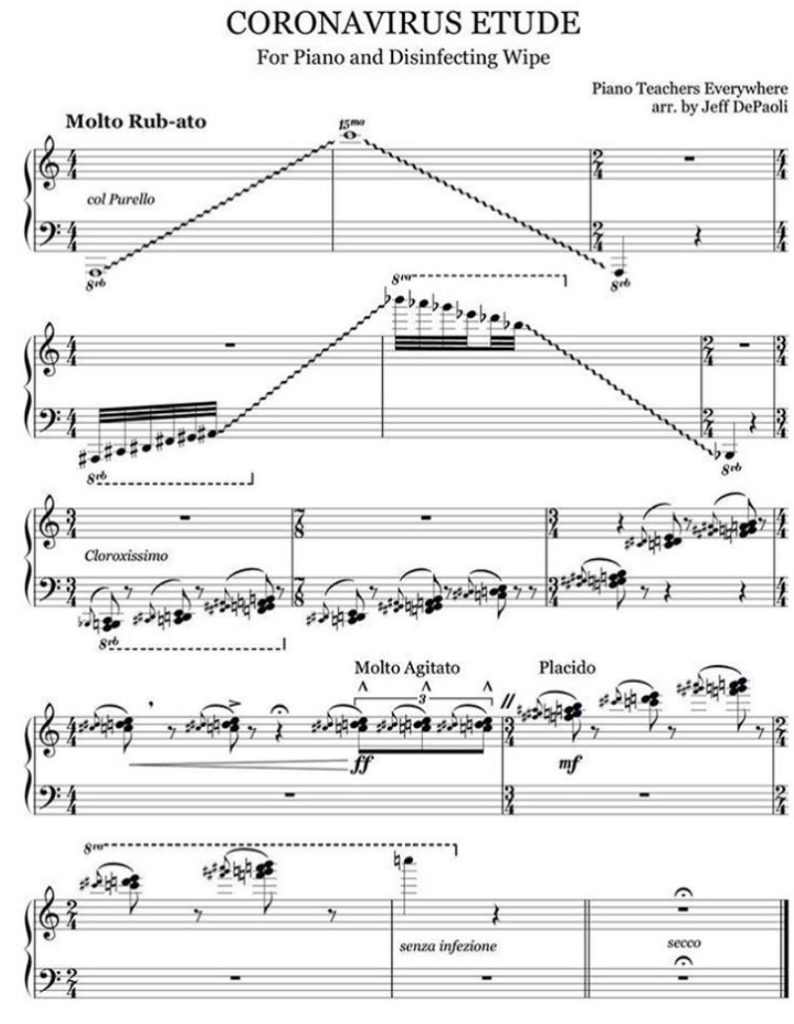You could disinfect your piano by grabbing a clorox wipe and playing the Coronavirus Etude. (Because we all could use a little humor about now.)
In all seriousness, special care should be taken when using disinfectant products on a piano.
My piano technician, David Love, sent me the following suggestions for taking care of pianos during the COVID-19 Pandemic.
General Recommendations
- Alcohol products should be used carefully on keys as the sharps of vintage pianos are often finished with shellac for which the solvent is alcohol. If not careful you can streak the black dye onto the white naturals. While it can generally be easily removed you will also be taking the finish off the sharps. Also, do not use bleach-based disinfectants or any product containing citrus. Windex disinfectant (non citrus), 409 or other similar products are generally safe, but always test first in a small area.
- If using a spray or liquid bottle, use a disposable towel like WYPALL L30. Put the disinfectant on the towel and not directly on the piano.
- After use, immediately put the towel or disinfectant hand wipe in the trash and wash your hands as the CDC recommends.
- Always follow up with a dry towel and never leave any liquids on the piano or keys.
Keys
The keys are the most important part. Generally speaking, most disinfecting wipes or sprays should be safe to use on the keys. If the keys are dirty, a gentle dishwashing solution can be used prior to disinfecting.
Case Parts
Always test the disinfectant in a discrete area before moving forward to ensure there is no adverse reaction. Check to make sure the finish does not come off on the wipe or towel, the finish discolors or changes sheen. If none of this happens after a few minutes, you should be able to proceed.
High gloss polyester is the most durable to almost any store-bought disinfectants. Always do the test first.
Polyurethane and lacquer finishes require a more careful approach. Disinfectant wipes and sprays may be harmful to these finishes.
For satin pianos, always wipe down the piano in the direction of the ‘hand rubbed' finish or grain. Going in the opposite direction may result in hazing or scratch marks.
Aged, alligatored, and damaged finishes are a challenge. It is difficult to know what is best to keep the integrity of the finish and still clean thoroughly. Always test an area and proceed with caution.
Cleaning pianos should be a gentle process, not a scrubbing process. Pressing hard or vigorous scrubbing may lead to scratching or removing the finish. Always proceed with caution and use common sense. Remember to wash your hands after you have thrown away the towels or wipes.
My Virtual Teaching
While I have been following David's suggestions, I'm also no longer sharing my piano with others. I'm teaching all my private piano lessons online via Zoom and FaceTime.
And, my online course, PIANO NINJA TRICKS: Double Your Piano Proficiency in Half Your Time, starts next week. Enrollment is open until 3/20/20.
If you're an amateur adult pianist and can't get to your “in person” piano lessons right now, it's the perfect coaching program to help reduce your stress during the pandemic. I'll be teaching you ninja tricks to help your start learning music with good habits. Before you know it, you'll have used your entire “Shelter in Place” quarantine time to learn music you've been wanting to play for years. Wouldn't that be a great use of your quarantine time?



Thank you both!